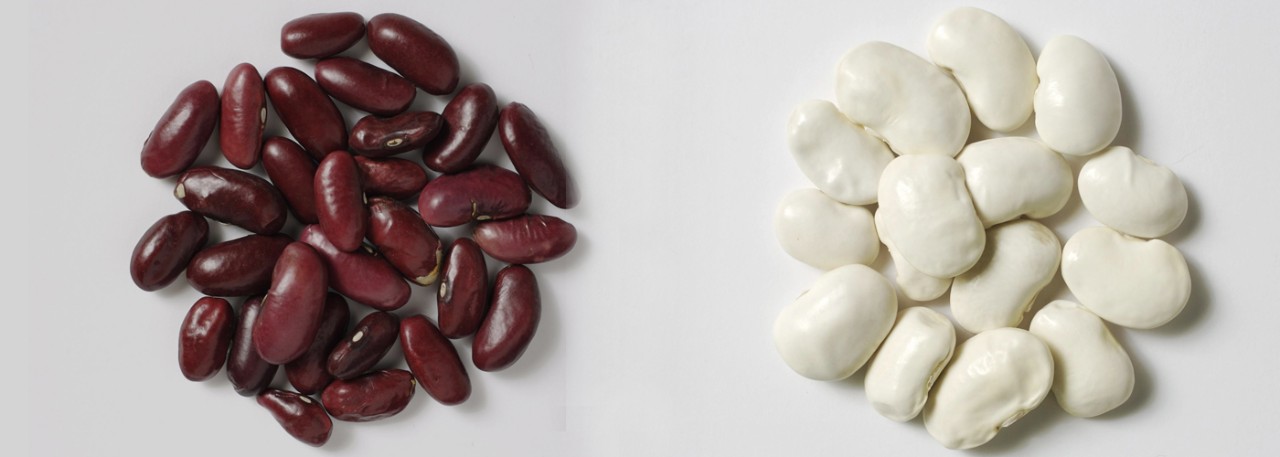.png.transform/rendition-xs/image_image%20(1).png)
Judías de El Barco de Ávila PGI
Dried, shelled beans from the family of pulses Phaselous vulgaris L. species, which comprises the varieties white Blanca redonda, Blanca riñón, Morada larga, Morada redonda, Arrocina, Planchada and Judión de Barco, whole and destined for human consumption.
Tasting notes
Soft texture, easy to digest, with an unmistakable flavor.
Other notes
Morphological characteristics of each of the varieties with regards to color, shape and size of the bean:
- Blanca redonda: white in color with an elliptical and full shape and medium size, about 160 beans/100g (3.5 oz) of seeds.
- Blanca de riñón: white in color with an oblong, half full, kidney shape and medium size, 169 beans/100g of seeds.
- Morada larga: dark purple in color, with a wide, flattened, kidney shape and medium size, about 150 beans/100g of seeds.
- Morada redonda: dark purple in color with a spherical, semi-full shape and medium size, 270 beans/100g of seeds.
- Judión de Barco: white in color with a wide, oblong shape and large size, about 100 beans/100g of seeds.
- Planchada: white in color with a short, flattened, kidney shape and medium size, about 170 beans/ g of seeds.
- Arrocina: white in color with a spherical shape and small size, about 400 beans/100g of seeds.
Production / Processing method
The land is prepared before sowing, which takes place in the second fortnight of May, and during which all varieties are sown at once. The sowing process is mechanized, as manual or drill sowing is not sufficiently effective, and the water used for irrigating the plants is surface water, free from calcium. The absence of calcium means that the dried beans develop a finer outer skin and have a lower calcium oxalate content in the walls of the cubic cells located below the outer skin. These characteristics influence cooking times, reducing them considerably.
Harvesting can either be done manually or mechanically. Manual harvesting is more commonly used and produces a better quality product. It involves harvesting pod by pod, without pulling up the plant. This type of harvesting can also be performed by pulling up the plant and then later separating the individual pods.
Next, once the bean is dry and mature, threshing or separating the bean from the pod takes place, either mechanically or manually. The cleaning process is then performed, in which the chaff and odd seeds are removed.
Once the beans reach the warehouses or packaging floors, they are subject to a process that consists of the following stages:
-An intrinsic quality control of the raw materials to standardize the different batches, which includes a cooking time analysis.
–Cleaning by air and vibration, to remove foreign bodies.
–Sifting and selecting to remove the defective beans.
– Calibration, in which the products are sorted by size, as only beans of the same size will have the same cooking time.
– Packaging: putting the beans into the different containers, using automatic and semi-automatic dosing units.
– Labeling: attaching labels and warnings to the container.
Geography / Relief and climate
The relief of the area is determined by the mountains and bare landscape that combine wooded areas and hillside pastures with terrace farming. The materials that form this area consist of igneous rocks.
The average altitude of the farming area is between 600 (1,968 ft) and 1,200 m (3,937 ft).
The soil of the production area, which is formed from the decomposition of granite and gneiss rock, is largely sandy and acidic. It is a light and well-balanced soil, free from drainage problems, with a low calcium and phosphorous content, variable nitrogen and potassium content and high organic material content, which provides it with a good structure.
The area has a pronounced continental climate with cold winters that are tempered in the area protected by the mountains. This favors the cultivation of pulses on the sunny hillsides and at the bottom of the valleys. The average temperature ranges from 11º C (51ª F), with the highest reaching 36º C (96ª F), and the lowest -10º C (14ª F).
The average annual rainfall is between 400 and 450 mm (15.76 – 17.73 in).
The production area is crossed by the River Tormes in its initial section, and by the eastern tributaries of the River Arevalle on the left and the Rivers Corneja and Almar on the right.
Regulatory Council
Consejo Regulador de la IGP Judías de El Barco de Ávila
C/ Mayor, 33
05600 El Barco de Ávila (Ávila)
Tel: (+34) 920 340 667
Fax: (+34) 920 340 667
jb@legumbresdecalidad.com
www.legumbresdecalidad.com
Sources:
- Spanish Ministry of Agriculture
Only beans of the same size will have the same cooking time.


- Judías de El Barco de Ávila 1
- Judías de El Barco de Ávila 2

El Barco de Ávila (Castile-Leon)
